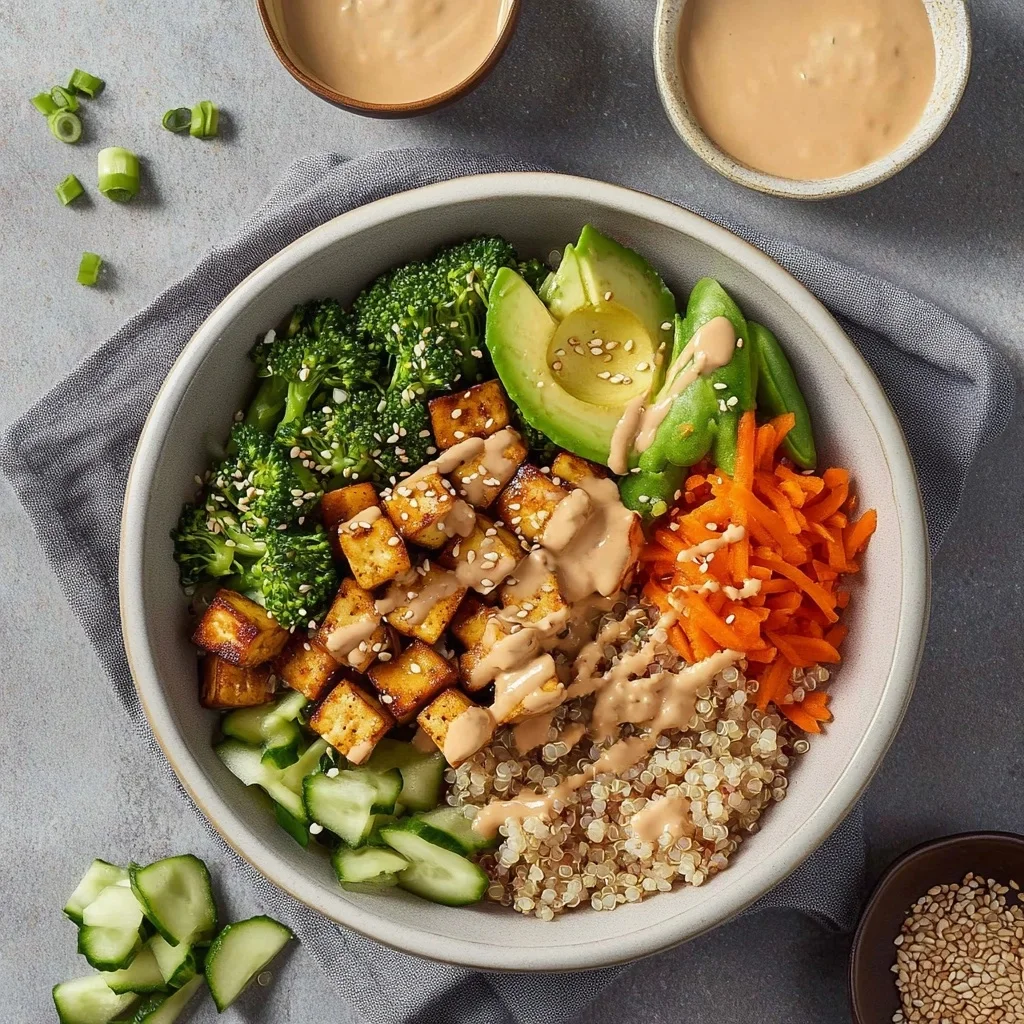Discover how to create the perfect Tofu Buddha Bowl packed with protein-rich tofu, nutrient-dense vegetables, and a creamy tahini drizzle that brings everything together in perfect harmony. This versatile, colorful meal delivers both exceptional flavor and complete nutrition in one beautiful bowl.
Introduction: Why Tofu Buddha Bowls Are the Perfect Balanced Meal
In today’s fast-paced world, finding meals that are both nutritious and satisfying can feel like an impossible challenge. Enter the Tofu Buddha Bowl—a vibrant, customizable meal that delivers protein, healthy fats, complex carbohydrates, and a rainbow of vegetables in one gorgeous package. Whether you’re a dedicated vegetarian, embracing Meatless Mondays, or simply looking to incorporate more plant-based meals into your routine, this Tofu Buddha Bowl recipe deserves a spot in your regular rotation.
Buddha bowls—also known as power bowls or grain bowls—have earned their place in the spotlight for good reason. Named for their round, full appearance (reminiscent of Buddha’s belly), these meals are built on the principle of balance, featuring a thoughtful combination of ingredients that nourish both body and soul. The Tofu Buddha Bowl takes this concept to new heights, featuring marinated tofu that even dedicated carnivores will enjoy, atop a bed of protein-packed quinoa and surrounded by a colorful array of fresh and cooked vegetables.
What truly sets this Tofu Buddha Bowl apart is its incredible versatility. You can easily swap ingredients based on seasonal availability, personal preferences, or simply what’s already in your refrigerator. The foundation remains the same: a grain base, protein-rich tofu, a rainbow of vegetables, and a flavor-packed sauce that brings it all together. It’s this adaptability that makes the Tofu Buddha Bowl a perfect meal prep option, weeknight dinner solution, or impressive yet effortless offering for guests with varied dietary needs.
In this comprehensive guide, I’ll walk you through creating the perfect Tofu Buddha Bowl from start to finish. You’ll learn the secrets to perfectly crispy tofu, how to build a bowl with balanced flavors and textures, and variations to keep this recipe fresh and exciting meal after meal. Let’s dive in and discover why the Tofu Buddha Bowl deserves a regular place in your meal planning!
Essential Ingredients: Building the Perfect Tofu Buddha Bowl
The Star Protein: Perfecting Your Tofu
The foundation of an outstanding Tofu Buddha Bowl begins with properly prepared tofu. Extra-firm tofu is essential here—it holds its shape better during cooking and creates that coveted crispy exterior while maintaining a tender interior. Here’s how to make the most of this versatile protein:
Pressing matters: Don’t skip pressing your tofu! This crucial step removes excess moisture, allowing the tofu to better absorb flavorful marinades and achieve a crispier texture when cooked. Place the tofu block between paper towels or clean kitchen towels, set a heavy skillet on top, and let it press for at least 15 minutes.
Marination magic: The marinade transforms bland tofu into a flavor powerhouse. The combination of soy sauce (for umami), rice vinegar (for brightness), toasted sesame oil (for nutty depth), and a touch of sweetness from honey or maple syrup creates a perfectly balanced flavor profile. For maximum impact, allow the tofu to marinate for at least 15 minutes, though longer is better—overnight marination in the refrigerator yields exceptional results.
Cutting technique: Aim for 3/4-inch cubes for the perfect balance between exterior crispness and interior tenderness. Uniform size ensures even cooking, creating tofu pieces that are golden on the outside and moist on the inside.
The Nutritious Base: Quinoa and Its Benefits
While many Buddha bowls use rice as their foundation, quinoa elevates this Tofu Buddha Bowl with additional protein and nutrients:
Complete protein source: Unlike most plant foods, quinoa contains all nine essential amino acids, making it a complete protein source—perfect for vegetarian and vegan diets.
Nutrient powerhouse: Quinoa delivers an impressive nutritional profile with significant amounts of manganese, phosphorus, magnesium, and folate, along with a good dose of fiber.
Cooking technique: Rinsing quinoa before cooking removes its natural coating called saponin, which can impart a bitter taste. The ideal 1:2 ratio of quinoa to liquid (vegetable broth adds extra flavor) and a gentle simmer creates perfectly fluffy quinoa every time.
For a variation that maintains the essence of the Tofu Buddha Bowl, consider brown rice, farro, or even cauliflower rice for a lower-carb option.
The Vibrant Vegetables: Creating Color and Nutrition
The vegetable selection in a Tofu Buddha Bowl serves multiple purposes—adding nutritional variety, vibrant colors, and contrasting textures:
Rainbow representation: Each color in fruits and vegetables represents different phytonutrients and health benefits. This recipe intentionally incorporates multiple colors: orange carrots (beta-carotene), purple cabbage (anthocyanins), green broccoli and onions (chlorophyll and sulforaphane), and creamy avocado (healthy monounsaturated fats).
Texture variation: The combination of raw and cooked vegetables creates an engaging eating experience. Crisp cucumber and cabbage provide refreshing crunch, while lightly steamed broccoli offers tenderness without sogginess. The creamy avocado adds a buttery contrast to the firmer elements.
Preparation tips: Cutting vegetables into appropriate sizes ensures they integrate well into the bowl. Thin slices or shreds of carrots and cabbage distribute their flavors throughout each bite, while broccoli florets should be small enough to eat in one or two bites without overwhelming the fork.
Feel free to customize the vegetable selection based on seasonal availability or personal preference—the Tofu Buddha Bowl concept embraces flexibility while maintaining the principle of colorful, nutritious variety.
The Flavorful Finish: Perfecting the Tahini Drizzle
What truly elevates a good Tofu Buddha Bowl to greatness is the sauce, and this tahini drizzle delivers exceptional flavor:
Balanced elements: The tahini provides a creamy base with nutty undertones, while soy sauce adds savory depth. Rice vinegar contributes necessary acidity, and the garlic powder offers aromatic complexity without overpowering the delicate flavors.
Texture considerations: The consistency of the sauce should be pourable but not watery—similar to heavy cream. Starting with a thicker mixture and gradually adding warm water gives you complete control over the final texture.
Application strategy: Rather than mixing the sauce throughout the bowl, drizzling it over the top maintains the visual appeal and allows each component to retain its distinct flavor while still contributing to the cohesive whole.
This tahini drizzle has become a staple in my kitchen, finding its way onto many dishes beyond this Tofu Buddha Bowl. Its versatility and balanced flavor profile make it worth preparing in larger batches to enjoy throughout the week.
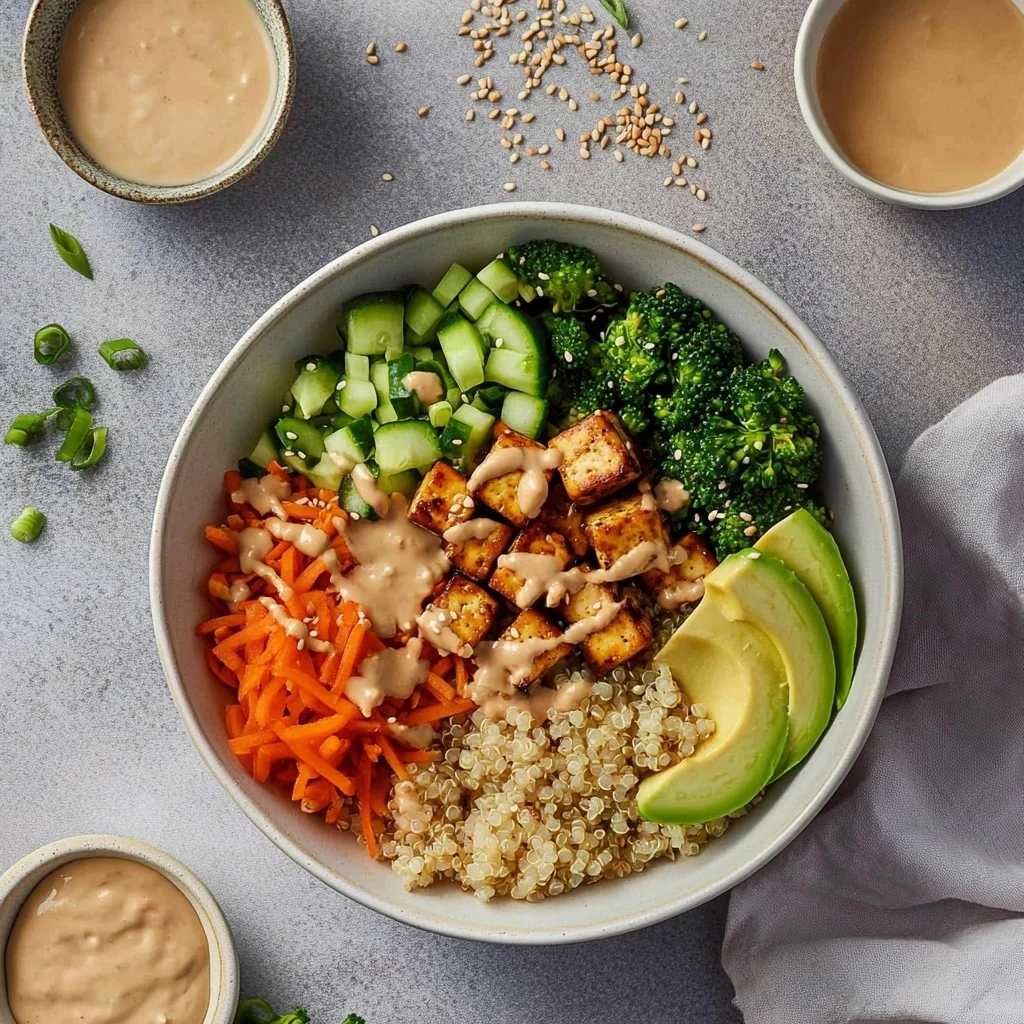
Step-by-Step Preparation: Creating Your Tofu Buddha Bowl
Marinating the Tofu for Maximum Flavor
The journey to a perfect Tofu Buddha Bowl begins with properly flavored tofu:
- After pressing your extra-firm tofu to remove excess moisture, cut it into evenly sized 3/4-inch cubes. Uniform pieces ensure consistent cooking and presentation.
- In a medium bowl, whisk together 2 tablespoons soy sauce, 1 tablespoon rice vinegar, 1 tablespoon toasted sesame oil, and 1 teaspoon honey or maple syrup. This balanced marinade provides umami, acidity, richness, and a touch of sweetness.
- Gently fold the tofu cubes into the marinade, taking care not to break them. For best results, use a shallow container that allows most pieces to contact the marinade.
- Allow the tofu to marinate for a minimum of 15 minutes, though longer marination—up to overnight in the refrigerator—yields more flavorful results. If marinating for more than 30 minutes, cover and refrigerate.
The marinade serves double duty—first infusing the tofu with flavor, then reducing into a glossy sauce that’s drizzled back over the tofu after cooking. This technique maximizes flavor while ensuring nothing goes to waste.
Cooking Perfect Fluffy Quinoa
While the tofu marinates, prepare the quinoa foundation:
- Place 1 cup of rinsed quinoa in a fine-mesh strainer and rinse thoroughly under cold water for about 30 seconds, agitating with your fingers. This removes the natural saponin coating that can impart bitterness.
- Transfer the rinsed quinoa to a small pot and add 2 cups of vegetable broth or water. Using broth instead of water adds significant depth of flavor without additional effort.
- Bring the liquid to a gentle boil over medium-high heat, then reduce to a simmer and cover with a tight-fitting lid. Cook for approximately 15 minutes, or until the liquid is absorbed and tiny spirals (the germ) separate from the seeds.
- Remove from heat but keep covered for an additional 5 minutes to allow the quinoa to steam and become perfectly fluffy. Then uncover and fluff gently with a fork to separate the grains.
Properly cooked quinoa should be tender but still have a slight bite, with distinct grains rather than a mushy consistency. This texture creates the ideal foundation for our Tofu Buddha Bowl.
Achieving Perfectly Seared Tofu
Creating tofu with a crispy exterior and tender interior requires attention to technique:
- Heat 1 tablespoon of olive oil in a non-stick or well-seasoned cast iron skillet over medium-high heat until shimmering but not smoking.
- Using a slotted spoon, transfer the marinated tofu to the hot pan, reserving the leftover marinade. Arrange the pieces in a single layer with space between them—overcrowding leads to steaming rather than searing.
- Allow the tofu to cook undisturbed for 3-4 minutes until golden brown on the bottom. Patience is key here—moving the tofu too soon prevents proper crust formation.
- Carefully flip each piece and sear for an additional 3-4 minutes on the opposite side. Then briefly cook the remaining sides for about 1 minute each for even browning.
- Once the tofu is crispy on all sides, transfer it to a plate. Pour the reserved marinade into the hot pan, where it will bubble and reduce quickly into a thickened sauce, about 30-60 seconds. Immediately pour this reduction over the tofu.
This last step—reducing the marinade into a glaze—is often overlooked but dramatically enhances the flavor intensity of the finished tofu in your Buddha bowl.
Preparing and Arranging the Vegetables
While the tofu cooks, prepare your vegetable components:
- Steamed broccoli: For bright green, tender-crisp broccoli, steam the florets for just 3-4 minutes. Immediately rinse under cold water to stop the cooking process and preserve the vibrant color.
- Raw vegetables: Using a mandoline or sharp knife, create thin, consistent slices of carrot, red cabbage, and cucumber. The uniformity not only creates visual appeal but ensures a balanced texture in each bite.
- Avocado: Slice just before serving to prevent browning. A perfectly ripe avocado should yield slightly to gentle pressure and add creamy richness to contrast with the crisper vegetables.
- Green onions: Slice on a diagonal for maximum visual impact, separating the white and green parts. The whites have a stronger flavor, while the greens provide a milder onion note and vibrant color.
The key to a successful Tofu Buddha Bowl lies partly in the vegetable preparation—each component should maintain its integrity while contributing to the cohesive whole.
Creating the Creamy Tahini Drizzle
This simple yet sophisticated sauce brings the entire Tofu Buddha Bowl together:
- In a small bowl, combine 3 tablespoons tahini, 1 tablespoon soy sauce, 1/2 tablespoon rice vinegar, 1 tablespoon warm water (initially), a pinch of garlic powder, and a pinch of salt.
- Whisk until smooth, paying special attention to the tahini, which can sometimes seize or become lumpy. The warm water helps prevent this issue.
- Assess the consistency—it should flow slowly off a spoon, similar to heavy cream. Add additional warm water, 1 teaspoon at a time, until you achieve the desired consistency. Patience here creates a perfect drizzle.
- Taste and adjust the flavors as needed: more soy sauce for saltiness, additional rice vinegar for tanginess, or a touch of honey/maple syrup if you prefer a slightly sweeter sauce.
This versatile sauce keeps well in the refrigerator for up to a week. Consider making a double batch to elevate salads, roasted vegetables, or grain bowls throughout your week.
Assembling the Buddha Bowl: The Art of Balance
The final assembly transforms individual components into a cohesive, beautiful meal:
- Start with a wide, shallow bowl to display all elements effectively. The ideal Buddha bowl allows you to see and access all components easily.
- Spread about 3/4 to 1 cup of the cooked quinoa as the foundation, creating a slightly flattened mound rather than piling it high.
- Arrange the components in distinct sections atop the quinoa—imagine dividing the bowl like a clock face and assigning each ingredient its own “time slot.”
- Position the tofu as the central protein, then arrange the vegetables in a rainbow pattern around it: purple cabbage, orange carrots, green broccoli, white/green cucumber, and yellow/green avocado.
- Sprinkle the green onions and toasted sesame seeds across the entire bowl for visual appeal and textural contrast.
- Finally, drizzle the tahini sauce in a deliberate pattern—either in concentric circles or a zigzag—using a spoon or squeeze bottle for precision.
This thoughtful arrangement creates not just a meal but a visual experience that enhances the enjoyment of your Tofu Buddha Bowl.
Nutritional Benefits: Why Tofu Buddha Bowls Support Overall Health
The Complete Nutritional Profile
The Tofu Buddha Bowl stands out as a nutritionally complete meal, providing balanced macronutrients and an impressive array of micronutrients:
Macronutrient balance: Each bowl delivers approximately 20-25g of plant-based protein (primarily from tofu and quinoa), 50-60g of complex carbohydrates (mainly from quinoa and vegetables), and 25-30g of healthy fats (from avocado, olive oil, sesame oil, and tahini). This balance creates lasting satiety while providing sustained energy.
Micronutrient density: The diverse ingredients contribute an exceptional range of vitamins and minerals:
- Vitamin A from carrots and broccoli
- B-complex vitamins from quinoa and tofu
- Vitamin C from broccoli and cabbage
- Vitamin E from avocado and olive oil
- Iron from tofu, quinoa, and dark leafy greens
- Calcium from tofu, tahini, and broccoli
- Magnesium from quinoa and dark green vegetables
- Zinc from quinoa and tofu
Fiber content: With approximately 12-15g of dietary fiber per serving from the quinoa, vegetables, and avocado, this bowl supports digestive health and promotes feelings of fullness—a critical factor in maintaining healthy eating patterns.
Each colorful component contributes unique phytonutrients, creating a meal that delivers comprehensive nutrition rather than isolated nutrients, aligning with current nutritional science that emphasizes whole foods over supplements.
Adapting to Dietary Requirements
One of the greatest strengths of the Tofu Buddha Bowl is its adaptability to various dietary needs:
Gluten-free modifications: This recipe is naturally gluten-free when using tamari instead of soy sauce. Always verify that your toasted sesame seeds are processed in a gluten-free facility if cross-contamination is a concern.
Vegan version: Simply replace honey with maple syrup in the tofu marinade for a completely plant-based meal that sacrifices nothing in flavor.
Lower-carb adaptation: Reduce the quinoa portion and increase non-starchy vegetables, or replace quinoa entirely with cauliflower rice for a keto-friendly version.
Higher-protein needs: Add edamame, hemp seeds, or a soft-boiled egg for additional protein without disrupting the bowl’s balance.
Anti-inflammatory focus: Emphasize turmeric in the tahini sauce and increase cruciferous vegetables like broccoli and cabbage, which contain compounds associated with reduced inflammation.
These adaptations allow the Tofu Buddha Bowl concept to serve virtually any dietary approach while maintaining its core principles of balance, nutrition, and visual appeal.
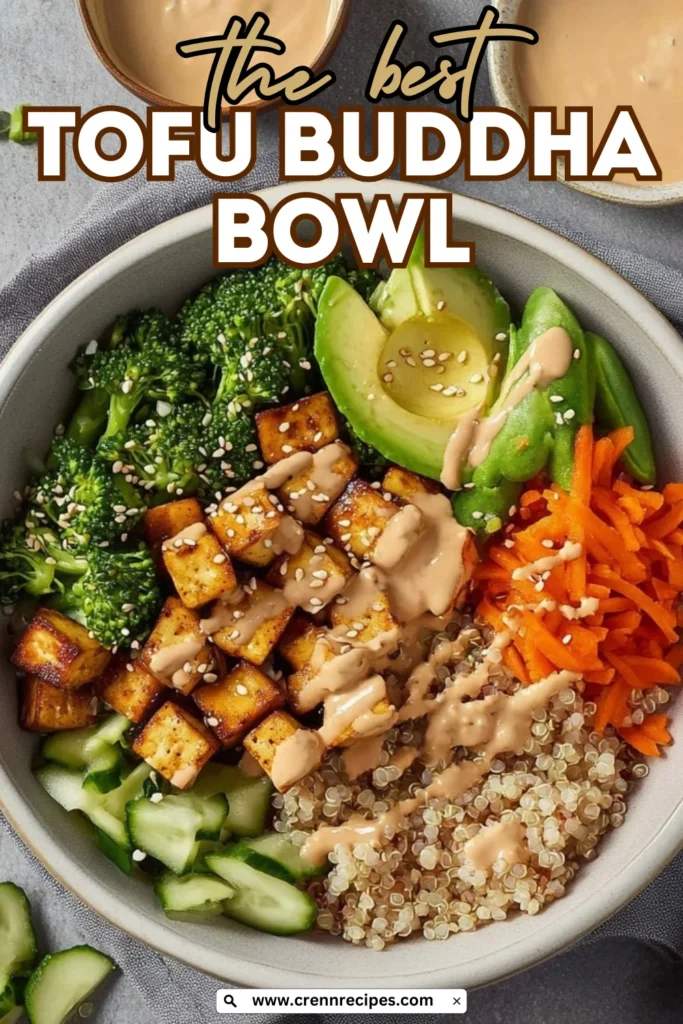
Variations and Customizations: Making the Tofu Buddha Bowl Your Own
Seasonal Adaptations
The Tofu Buddha Bowl concept shines when adapted to showcase seasonal produce:
Spring variations: Incorporate tender asparagus, sweet peas, and peppery radishes for a celebration of early harvests. A lemon-dill tahini drizzle complements these lighter spring vegetables.
Summer adaptations: Feature juicy cherry tomatoes, sweet corn kernels, and bell peppers at their peak freshness. A basil-infused tahini or cilantro-lime drizzle adds brightness appropriate to the season.
Fall modifications: Showcase roasted sweet potatoes, Brussels sprouts, and crisp apples for a heartier autumnal bowl. A maple-ginger tahini sauce creates warming comfort.
Winter versions: Incorporate roasted root vegetables like carrots, parsnips, and beets alongside sturdy greens like kale. A garlic-rosemary tahini drizzle provides comforting depth during colder months.
These seasonal adaptations maintain the essence of the Tofu Buddha Bowl while celebrating nature’s changing bounty and ensuring year-round enjoyment of local, fresh ingredients.
Global Flavor Profiles
The Tofu Buddha Bowl provides an excellent canvas for exploring global cuisine through flavor variations:
Mediterranean inspiration: Marinate tofu in lemon, garlic, and oregano; include cucumber, tomato, and olives; and finish with a tzatziki-inspired yogurt-tahini sauce.
Mexican influence: Incorporate chili powder and lime in the tofu marinade; add black beans, corn, and avocado; and top with a cilantro-lime tahini drizzle and pickled red onions.
Japanese adaptation: Use miso in the tofu marinade; include edamame and daikon radish; and finish with a wasabi-ginger tahini sauce and seaweed garnish.
Indian variation: Marinate tofu with garam masala; include chickpeas and cauliflower; and finish with a curry-infused tahini drizzle and cucumber raita.
These global variations maintain the nutritional balance and bowl format while offering exciting flavor journeys that prevent mealtime monotony.
Serving and Storage: Practical Tips for Enjoyment
Presentation Strategies for Maximum Appeal
The visual presentation of your Tofu Buddha Bowl significantly enhances the eating experience:
Bowl selection: Choose wide, shallow bowls with a slight curve that displays all components while containing them properly. White or neutral-colored dishes make the vibrant ingredients pop visually.
Arrangement techniques: Position ingredients in a clock-like arrangement for visual organization, or create a “gradient” effect by arranging components from lightest to darkest. Keep the quinoa visible at the edges rather than completely covered.
Garnish impact: Reserve some of the most colorful ingredients—like green onions, sesame seeds, or microgreens—to sprinkle on top just before serving for maximum visual freshness.
Sauce application: Apply the tahini drizzle with intention, either in a spiral pattern starting from the center or in artistic zigzags. A squeeze bottle offers precision for more elaborate presentations.
These presentation strategies create a meal that delights the eyes before the first bite, enhancing the overall dining experience.
Meal Prep and Storage Guidelines
The Tofu Buddha Bowl components can be prepared in advance for convenient, healthy meals throughout the week:
Component preparation: Prepare and store individual elements separately for maximum freshness:
- Marinate and cook tofu up to 3 days ahead
- Cook quinoa up to 5 days in advance
- Prepare heartier vegetables like broccoli, carrots, and cabbage up to 3 days ahead
- Mix the tahini sauce up to 7 days in advance
Assembly strategy: For meal prep, layer components in storage containers with hardier items at the bottom and more delicate ingredients (like avocado) added fresh just before eating.
Reheating recommendations: Quinoa and tofu can be enjoyed cold or gently warmed. If reheating, do so separately before assembling the bowl, and add fresh components after warming.
Freshness preservation: Store prepared components in airtight containers with a small piece of paper towel to absorb excess moisture, maximizing crispness and preventing sogginess.
With these practical strategies, the Tofu Buddha Bowl becomes not just a delicious one-time meal but a sustainable approach to healthy eating throughout your busy week.
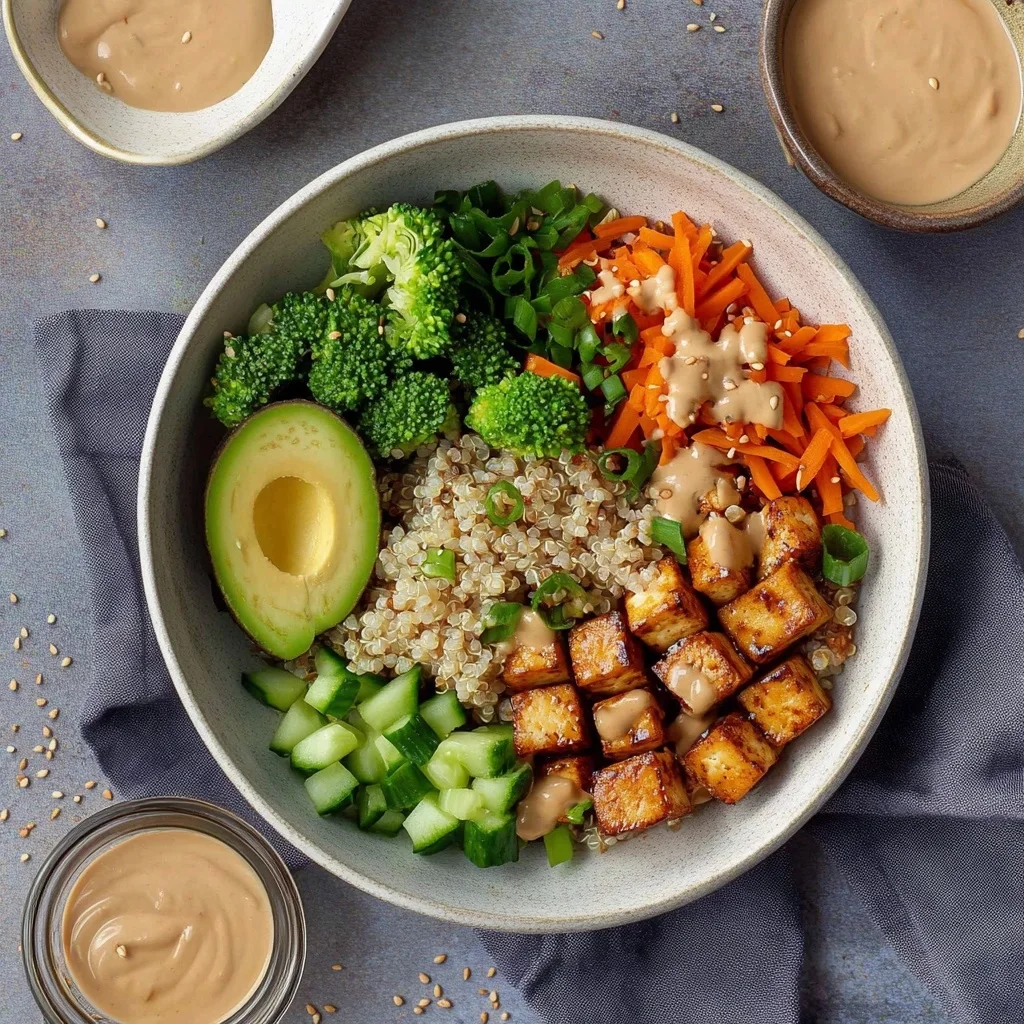
Frequently Asked Questions About Tofu Buddha Bowls
How do I prevent my tofu from being soggy?
The key to crispy tofu lies in three critical steps: First, use extra-firm tofu and press it thoroughly for at least 15 minutes between towels with a heavy weight on top. Second, ensure your pan is properly heated before adding the tofu—the oil should shimmer but not smoke. Finally, resist the urge to move the tofu too frequently; allow each side to develop a golden crust before flipping. For even crispier results, you can toss the marinated tofu cubes in 1 tablespoon of cornstarch before searing.
Can I prepare Tofu Buddha Bowls for meal prep?
Absolutely! Tofu Buddha Bowls are ideal for meal preparation. Cook the tofu and quinoa, and prepare most vegetables up to 3 days in advance. Store components separately in airtight containers. For maximum freshness, prepare the tahini sauce ahead but add delicate ingredients like avocado and garnishes just before serving. When assembling ahead, layer items strategically with denser ingredients at the bottom and the sauce in a separate container to prevent sogginess.
What can I substitute for quinoa if I don’t have it on hand?
Quinoa can be easily replaced with other grains while maintaining the integrity of your Tofu Buddha Bowl. Brown rice offers a similar nutritional profile with a slightly chewier texture. Farro provides a nutty flavor and pleasantly chewy bite. For a lower-carb option, cauliflower rice works beautifully. Even cooked buckwheat, barley, or millet make excellent substitutions—each bringing its unique texture and flavor while serving the same purpose as the bowl’s foundation.
How can I make my Tofu Buddha Bowl more filling?
To create a more satiating Tofu Buddha Bowl, consider these adjustments: Increase the protein by adding edamame, chickpeas, or a soft-boiled egg. Boost healthy fats by incorporating additional avocado, a sprinkle of nuts or seeds, or a more generous drizzle of tahini sauce. You can also increase the portion of quinoa or add roasted sweet potatoes for additional complex carbohydrates. These modifications maintain the bowl’s balanced approach while providing more calories and staying power.
Conclusion: Why the Tofu Buddha Bowl Deserves a Regular Place in Your Meal Rotation
The Tofu Buddha Bowl represents far more than just another healthy recipe—it embodies a thoughtful approach to nourishment that balances flavor, nutrition, visual appeal, and practicality. By combining protein-rich marinated tofu, nutrient-dense quinoa, a rainbow of vegetables, and a creamy tahini drizzle, this bowl delivers complete nutrition in a form that delights all the senses.
What sets the Tofu Buddha Bowl apart from other health-focused meals is its remarkable flexibility. The basic template adapts effortlessly to seasonal produce, global flavor profiles, and individual dietary needs without sacrificing its fundamental benefits. This adaptability makes it a sustainable approach to healthy eating rather than a rigid recipe that quickly becomes monotonous.
Perhaps most importantly, the Tofu Buddha Bowl represents the kind of balanced, plant-forward eating that both nutritional science and culinary tradition celebrate. It honors whole ingredients, embraces variety, and creates satisfaction through thoughtful combination rather than restriction or deprivation.
I encourage you to make the Tofu Buddha Bowl your own—experiment with seasonal adaptations, explore global flavor variations, and discover the combination that speaks to your personal preferences. In doing so, you’ll cultivate not just a recipe but a template for nourishing, delicious meals that can evolve alongside your tastes and needs.
More Related Recipes You Might Enjoy
- Quinoa Power Bowl – Another nutrient-packed grain bowl featuring protein-rich quinoa and colorful vegetables
- Buddha Noodle Bowl – A delicious variation with noodles instead of grains for a different texture experience
- Quinoa Mediterranean Bowl – Enjoy the same quinoa base with Mediterranean-inspired flavors and ingredients
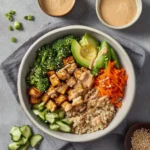
Tofu Buddha Bowl: 7 Incredible Health Benefits You’ll Love
- Total Time: 50 minutes
- Yield: 4 servings 1x
- Diet: Vegetarian
Description
A vibrant and nutritious Tofu Buddha Bowl featuring perfectly seared marinated tofu, fluffy quinoa, and a rainbow of fresh vegetables, all brought together with a creamy tahini drizzle. This balanced meal delivers complete protein, healthy fats, and complex carbohydrates in one beautiful bowl.
Ingredients
- 14 oz extra-firm tofu (pressed and cubed)
- 2 tablespoons soy sauce
- 1 tablespoon rice vinegar
- 1 tablespoon toasted sesame oil
- 1 teaspoon honey or maple syrup
- 2 tablespoons olive oil (divided)
- 1 cup quinoa (rinsed)
- 2 cups vegetable broth or water
- 1 large carrot (shredded or thinly sliced)
- 1 cup red cabbage (thinly sliced)
- 1 avocado (sliced)
- 1 cup cucumber (diced)
- 1 cup steamed broccoli florets
- 2 green onions (thinly sliced)
- 2 tablespoons toasted sesame seeds
For the Tahini Drizzle:
- 3 tablespoons tahini
- 1 tablespoon soy sauce
- ½ tablespoon rice vinegar
- 1 tablespoon warm water (more to thin)
- Pinch of garlic powder
- Pinch of salt
Instructions
- In a medium bowl, whisk together soy sauce, rice vinegar, toasted sesame oil, and honey (or maple syrup). Add cubed tofu and gently toss to coat. Marinate for at least 15 minutes.
- Add rinsed quinoa and vegetable broth to a small pot, bring to a gentle boil, then cover and reduce to a simmer for about 15 minutes until water is absorbed. Fluff with a fork and keep warm.
- Heat 1 tablespoon olive oil in a skillet over medium-high heat. Add marinated tofu (reserving leftover marinade) and sear each side until golden, about 3–4 minutes per side. Remove tofu, then pour leftover marinade into the hot pan, letting it bubble and thicken for a minute before drizzling back over the tofu.
- Prepare vegetables: shred or slice carrots, thinly slice red cabbage, dice cucumber, steam broccoli until bright green and tender-crisp, and slice avocado.
- Make tahini drizzle by whisking together tahini, soy sauce, rice vinegar, warm water, garlic powder, and salt. Add more warm water as needed for desired consistency.
- Assemble bowls by adding a base of quinoa, then arranging tofu, carrots, red cabbage, cucumber, broccoli, and avocado on top. Sprinkle with sesame seeds and green onions.
- Drizzle tahini sauce over the top and serve immediately.
Notes
- For meal prep, store components separately and assemble just before eating.
- To make this recipe vegan, use maple syrup instead of honey.
- For a gluten-free version, substitute tamari for soy sauce.
- Pressing tofu is essential for the best texture – place between paper towels with a heavy weight on top for at least 15 minutes.
- Customize with your favorite seasonal vegetables or whatever you have on hand.
- Prep Time: 25 minutes
- Cook Time: 25 minutes
- Category: Main Dish
- Method: Stovetop
- Cuisine: Asian-Inspired
Nutrition
- Serving Size: 1 bowl
- Calories: 420
- Sugar: 4g
- Sodium: 680mg
- Fat: 22g
- Saturated Fat: 3g
- Unsaturated Fat: 18g
- Trans Fat: 0g
- Carbohydrates: 44g
- Fiber: 9g
- Protein: 18g
- Cholesterol: 0mg

